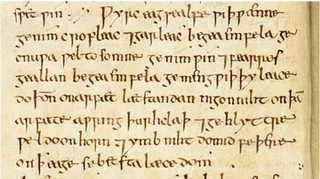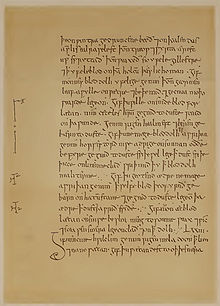
Medieval medicine in Western Europe was composed of a mixture of pseudoscientific ideas from antiquity. In the Early Middle Ages, following the fall of the Western Roman Empire, standard medical knowledge was based chiefly upon surviving Greek and Roman texts, preserved in monasteries and elsewhere. Medieval medicine is widely misunderstood, thought of as a uniform attitude composed of placing hopes in the church and God to heal all sicknesses, while sickness itself exists as a product of destiny, sin, and astral influences as physical causes. On the other hand, medieval medicine, especially in the second half of the medieval period, became a formal body of theoretical knowledge and was institutionalized in the universities. Medieval medicine attributed illnesses, and disease, not to sinful behaviour, but to natural causes, and sin was connected to illness only in a more general sense of the view that disease manifested in humanity as a result of its fallen state from God. Medieval medicine also recognized that illnesses spread from person to person, that certain lifestyles may cause ill health, and some people have a greater predisposition towards bad health than others.

A herbal is a book containing the names and descriptions of plants, usually with information on their medicinal, tonic, culinary, toxic, hallucinatory, aromatic, or magical powers, and the legends associated with them. A herbal may also classify the plants it describes, may give recipes for herbal extracts, tinctures, or potions, and sometimes include mineral and animal medicaments in addition to those obtained from plants. Herbals were often illustrated to assist plant identification.

The Textus Roffensis, fully titled the Textus de Ecclesia Roffensi per Ernulphum episcopum and sometimes also known as the Annals of Rochester, is a mediaeval manuscript that consists of two separate works written between 1122 and 1124. It is catalogued as "Rochester Cathedral Library, MS A.3.5" and as of 2023 is currently on display in a new exhibition at Rochester Cathedral, Rochester, Kent. It is thought that the main text of both manuscripts was written by a single scribe, although the English glosses to the two Latin entries were made by a second hand. The annotations might indicate that the manuscript was consulted in some post-Conquest trials. However, the glosses are very sparse and just clarify a few uncertain terms. For example, the entry on f. 67r merely explains that the triplex iudiciu(m) is called in English, ofraceth ordel.

The Lacnunga ('Remedies') is a collection of miscellaneous Anglo-Saxon medical texts and prayers, written mainly in Old English and Latin. The title Lacnunga, an Old English word meaning 'remedies', is not in the manuscript: it was given to the collection by its first editor, Oswald Cockayne, in the nineteenth century. It is found, following other medical texts, in London, British Library Harley MS 585, a codex probably compiled in England in the late tenth or early eleventh century. Many of its herbal remedies are also found, in variant form, in Bald's Leechbook, another Anglo-Saxon medical compendium.
"Wið færstice" is an Old English medical text surviving in the collection known now as Lacnunga in the British Library. Wið fǣrstiċe[wiðˈfæːrˌsti.t͡ʃe] means 'against a sudden/violent stabbing pain'; and according to Felix Grendon, whose collection of Anglo-Saxon charms appeared in the Journal of American Folklore in 1908, “the charm is intended to cure a sudden twinge or stitch, possibly rheumatism that can be due to being shot by witches, elves, and other spirits that fly through the air.” Scholars have often sought to identify this as rheumatism, but other possibilities should not be excluded. The remedy describes how to make a salve, but its main interest lies in the unique charm which follows. This describes how the færstice has been caused by the projectiles of 'mighty women', whom the healer will combat. The charm also mentions elves, believed responsible for elfshot, and provides the only attestation outside personal names of the Old English form of the name of the old Germanic gods, known as the Æsir in Norse mythology.

Pseudo-Apuleius is the name given in modern scholarship to the author of a 4th-century herbal known as Pseudo-Apuleius Herbarius or Herbarium Apuleii Platonici. The author of the text apparently wished readers to think that it was by Apuleius of Madaura (124–170 CE), the Roman poet and philosopher, but modern scholars do not believe this attribution. Little or nothing else is known of Pseudo-Apuleius apart from this.
Saint Eormenhild is a 7th-century Anglo-Saxon saint venerated in the Eastern Orthodox and Roman Catholic churches.
Byrhtferth was a priest and monk who lived at Ramsey Abbey in Huntingdonshire in England. He had a deep impact on the intellectual life of later Anglo-Saxon England and wrote many computistic, hagiographic, and historical works. He was a leading man of science and best known as the author of many different works. His Manual (Enchiridion), a scientific textbook, is Byrhtferth's best known work.

Sempervivum tectorum, the common houseleek, is a species of flowering plant in the family Crassulaceae, native to the mountains of southern Europe, cultivated in the whole of Europe for its appearance and a Roman tradition claiming that it protects buildings against lightning strikes.
The Nine Herbs Charm, Nigon Wyrta Galdor, Lay of the Nine Healing Herbs, or Nine Wort Spell is an Old English charm recorded in the tenth-century CE. Anglo-Saxon medical compilation known as Lacnunga, which survives on the manuscript, Harley MS 585, in the British Library, in London. The charm involves the preparation of nine plants.
The Medicina Plinii or Medical Pliny is an anonymous Latin compilation of medical remedies dating to the early 4th century AD. The excerptor, saying that he speaks from experience, offers the work as a compact resource for travelers in dealing with hucksters who sell worthless drugs at exorbitant prices or with know-nothings only interested in profit. The material is presented in three books in the conventional order a capite ad calcem, the first dealing with treatments pertaining to the head and throat, the second the torso and lower extremities, and the third systemic ailments, skin diseases, and poisons.
The title "(The) Seasons for Fasting" refers to an incomplete Old English homiletic poem, that which deals primarily with the observance of fasts on the appropriate dates of the liturgical calendar, but which also attacks the misbehaviour of lax priests. The piece appears to have been composed by a clergyman and directed at a lay audience, addressed as folces manna in line 212, whom he perhaps believed to have been potentially misguided.
Anglo-Saxon metrical charms were sets of instructions generally written to magically resolve a situation or disease. Usually, these charms involve some sort of physical action, including making a medical potion, repeating a certain set of words, or writing a specific set of words on an object. These Anglo-Saxon charms tell a great deal about medieval medical theory and practice. Although most medical texts found from the pre-Christian Anglo-Saxon period are translations of Classical texts in Latin, these charms were originally written in Old English.
Magic in Anglo-Saxon England refers to the belief and practice of magic by the Anglo-Saxons between the fifth and eleventh centuries AD in Early Mediaeval England. In this period, magical practices were used for a variety of reasons, but from the available evidence it appears that they were predominantly used for healing ailments and creating amulets, although it is apparent that at times they were also used to curse.

Three Anglo-Saxon metrical charms "Against a dwarf" are contained within the Lacnunga, which seek to heal an afflicted person by ridding them of a dwarf.
On the Resting-Places of the Saints is a heading given to two early medieval pieces of writing, also known as Þá hálgan and the Secgan, which exist in various manuscript forms in both Old English and Latin, the earliest surviving manuscripts of which date to the mid-11th century. Secgan is so named from its Old English incipit, Secgan be þam Godes sanctum þe on Engla lande aerost reston "Tale of God's saints who first rested in England"), and is a list of fifty places which had shrines and remains of Anglo-Saxon saints. Þá hálgan is a version of the so-called Kentish Royal Legend is a heading which appears to be for both texts, as the Kentish legend, which comes first, is actually an account of how various members of the royal family of Kent, descendants of Æthelberht of Kent, founded monasteries and came to be regarded as saints. As such it is closer to other hagiographical texts than to the list of burial sites that follows it. The texts describe people living from the 7th to 10th centuries, and they exist in both Old English and Latin versions, but both have their earliest known manuscripts dating from the 11th century.
The Kentish Royal Legend is a diverse group of Medieval texts which describe a wide circle of members of the royal family of Kent from the 7th to 8th centuries AD. Key elements include the descendants of Æthelberht of Kent over the next four generations; the establishment of various monasteries, most notably Minster-in-Thanet; and the lives of a number of Anglo-Saxon saints and the subsequent travels of their relics. Although it is described as a legend, and contains a number of implausible episodes, it is placed in a well attested historical context.
The so-called "For Delayed Birth" is an Old English poetic medical text found in the manuscript London, British Library, Harley 585, ff. 185r-v, in a collection of medical texts known since the nineteenth century as Lacnunga (‘remedies’). The manuscript was probably copied in the early eleventh century, though its sources may have been older.
Thomas Oswald Cockayne (1807–1873) was a churchman and philologist, best known today for his monumental edition of Old English medical texts.

Bald's eyesalve is an early medieval English medicine recorded in the 10th-century Anglo-Saxon Bald's Leechbook. It is described as a treatment for a "wen", a lump in the eye. The ingredients include garlic, another Allium, wine and bovine bile, crushed and mixed together before being left to stand for nine days.







